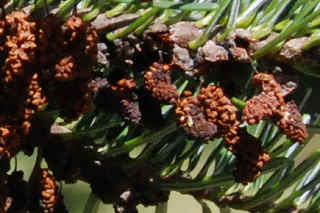Are you sneezing yet? If so, it's more likely to be from grass pollen than that produced by conifers. Although conifers produce great amounts of pollen, it's generally not as likely to cause allergies as other sources. Pines, in particular, generate great yellow clouds of pollen. But the pollen grains are larger and heavier and less likely to travel far enough to cause allergy problems. On the other hand, the pollen from the cypress family, especially junipers, cause more allergic reactions.
Here is a short update on the development of pollen cones, which I've been following this spring. The photos here show two stages of Pacific Silver Fir (
Abies amabilis) pollen cone development. In the first photo, you can see the tiny pollen sacs on each cone. The cones begin to elongate and and the pollen sacs separate along a short stem. Then the pollen sacs dry out and burst open releasing the pollen into the air. The photo on the right shows a cone after pollen release.
Later, the pollen cones wither and turn brown. They can remain on the tree for a some time, but eventually they fall off. These photos were taken at Hoyt Arboretum in Portland. Since Pacific Silver Firs naturally grow in the higher elevations of the Cascade Mountains, they will be shedding pollen later this spring.
Pollen cones on other conifers develop in a similar way. Here are the pollen cones of Western Hemlock (
Tsuga heterophylla), which disperse their pollen in April. These trees grow at lower elevations in the Northwest. If you are allergic to pollen and start sneezing as you hike the trails of Portland's Forest Park, these won't be the culprits. The only native conifer there with allergenic pollen is Western Red Cedar
Thuja plicata.



Our pinon pines do produce quite a bit of pollen down here, but the DUST wind every time. Nice entry!
ReplyDeleteLots of yellow pollen on our solar panels lately. Good thing we got some heavy rain yesterday!
ReplyDeleteReally interesting read! I never realized how different conifer pollen types affect allergies. It makes me wonder if reactions could go beyond sneezing—like when people ask, can allergies cause chills and body aches?
ReplyDelete